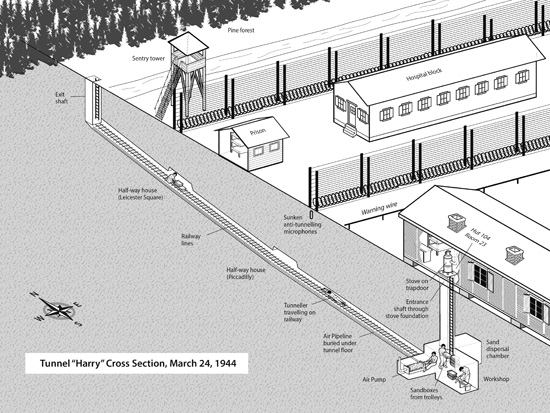
Just nine days after the tunnellers’ nemesis, Karl Griese (Rubberneck), went on leave – on Feb. 29, 1944 – Tunnel “Harry” had been extended the 100 feet that – based on underground measurements – the escape committee figured put its main escape route beyond the wire, beyond the road and well into the pine forest. Thus, on March 10, 1944 the diggers carved out what would be the base of the vertical shaft soon to be dug to the surface about 30 feet above them.
But the configuration of the digging team had changed dramatically since it first broke through the chimney foundation in Hut 104 almost a year before. Wally Floody, the tunnel king was gone – purged to Belaria POW camp on Feb. 29.
And John Weir, the digger from Toronto, was gone – off to a German hospital near Frankfurt-am-Main where he underwent skin-graft surgery to reconstruct his eyelids (burned off when his Spitfire was hit by enemy fire in November 1941).
Since December 1941, Flying Officer John Weir had been writing regularly to his fiancée Frances McCormack in Toronto. Naturally, Fran had become accustomed to his words of love and longing to be with her. But she also began to understand he wasn’t sitting idly by waiting for the war to end. He had told her of his German language lessons, sent her pictures of himself and his Canadian fellow kriegies. But John Weir had also sent Fran a coded request.
“The pajamas you sent in the July parcel just came in time,” he had written in 1942. “My others were sort of on their bum ends.”
And when he kept asking for more pairs of silk pajamas, and she obliged, she sensed her fiancé was up to something. Indeed, in place of street clothes or digging naked (both of which could reveal yellow stains or scratches sustained by tunnelling activity), Weir’s silk pajamas served as easily disposable, very resistant to sand stains, digging outfits for the tunnellers. And Weir’s fiancée – though not sure how – was a willing and able accomplice to her husband’s escape activity at Stalag Luft III.